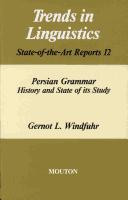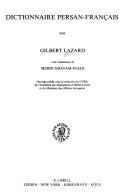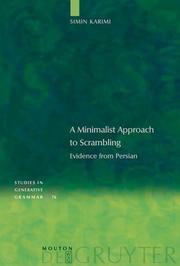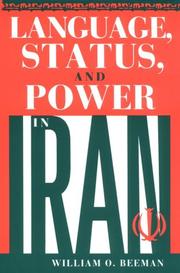| Listing 1 - 10 of 32 | << page >> |
Sort by
|
Book
ISBN: 3882260645 Year: 1979 Volume: 10 Publisher: Wiesbaden Reichert
Abstract | Keywords | Export | Availability | Bookmark
 Loading...
Loading...Choose an application
- Reference Manager
- EndNote
- RefWorks (Direct export to RefWorks)
Persian language --- Dialects --- -Farsi language --- Iranian languages --- -Persian language --- -Dialects --- Farsi language
Book
ISBN: 3111442624 9783111442624 Year: 2012 Publisher: [Berlin] De Gruyter
Abstract | Keywords | Export | Availability | Bookmark
 Loading...
Loading...Choose an application
- Reference Manager
- EndNote
- RefWorks (Direct export to RefWorks)
Dieser Titel aus dem De Gruyter-Verlagsarchiv ist digitalisiert worden, um ihn der wissenschaftlichen Forschung zugänglich zu machen. Da der Titel erstmals im Nationalsozialismus publiziert wurde, ist er in besonderem Maße in seinem historischen Kontext zu betrachten. Mehr erfahren Sie hier. This title from the De Gruyter Book Archive has been digitized in order to make it available for academic research. It was originally published under National Socialism and has to be viewed in this historical context. Learn more ref=https://www.degruyter.com/page/2052›here.
Persian language --- Farsi language --- Iranian languages --- Spoken Persian.
Book
ISBN: 1282105469 9786612105463 9027290687 9789027290687 9027255113 Year: 2008 Publisher: Amsterdam Philadelphia John Benjamins Pub.
Abstract | Keywords | Export | Availability | Bookmark
 Loading...
Loading...Choose an application
- Reference Manager
- EndNote
- RefWorks (Direct export to RefWorks)
Persian language --- Farsi language --- Iranian languages --- Aspect. --- Mood. --- Negatives. --- Verb.

ISBN: 311080042X 9783110800425 9027977747 9789027977748 Year: 2011 Publisher: Berlin Boston
Abstract | Keywords | Export | Availability | Bookmark
 Loading...
Loading...Choose an application
- Reference Manager
- EndNote
- RefWorks (Direct export to RefWorks)
Persian language --- Farsi language --- Iranian languages --- Grammar --- History. --- Grammar.

ISBN: 9004085491 Year: 1990 Publisher: Leiden Brill
Abstract | Keywords | Export | Availability | Bookmark
 Loading...
Loading...Choose an application
- Reference Manager
- EndNote
- RefWorks (Direct export to RefWorks)
Persian language --- Persan (Langue) --- Dictionaries --- French --- Dictionnaires français --- -Farsi language --- Iranian languages --- -French --- -Dictionaries --- Dictionnaires français --- Farsi language --- Dictionaries&delete&
Book
ISBN: 1443810134 9781443810135 1299645518 9781299645516 1847186394 9781847186393 9781443810135 Year: 2008 Publisher: Newcastle upon Tyne : Cambridge Scholars Publishing,
Abstract | Keywords | Export | Availability | Bookmark
 Loading...
Loading...Choose an application
- Reference Manager
- EndNote
- RefWorks (Direct export to RefWorks)
Aspects of Iranian Linguistics introduces readers to recent research into various properties of a number of Iranian languages. The volume consists of twenty chapters that cover a full range of Iranian linguistics, including formal theoretical perspectives (from a syntactic and morphological point of view), typological and functional perspectives, and diachronic and areal perspectives. It also contains papers on computational linguistics and neurolinguistics, as well as the modern history of ...
Iranian languages --- Persian language --- Farsi language --- Eranian languages --- Indo-Iranian languages
Book
ISBN: 9004274413 9789004274419 1322348588 9781322348582 9789004243026 900424302X Year: 2014 Publisher: Leiden Boston
Abstract | Keywords | Export | Availability | Bookmark
 Loading...
Loading...Choose an application
- Reference Manager
- EndNote
- RefWorks (Direct export to RefWorks)
In Semantic Spaces of Persian Light Verbs , Neiloufar Family exposes the semantic organization of light verb constructions in Persian. By clustering constructions based on semantic properties, she provides an insightful and more global view of a system that has been notoriously difficult to classify. Using diagrams as visual aids, Neiloufar Family takes a novel, bottom-up approach to analysing the light verb system, starting from small sets of constructions and mapping out consistent patterns. Her analysis leads to a deeper understanding of the structure of semantic spaces within the verbal system in Persian, and other languages that use light verbs. This research provides a blueprint for understanding existing verbal constructions and productively creating new ones.
Persian language --- Farsi language --- Iranian languages --- Verb. --- Compound words. --- Semantics. --- Grammar.

ISBN: 3110182963 9783110182965 9783110199796 3110199793 9783110182965 128339667X 9781283396677 9786613396679 6613396672 Year: 2005 Publisher: Berlin Mouton de Gruyter
Abstract | Keywords | Export | Availability | Bookmark
 Loading...
Loading...Choose an application
- Reference Manager
- EndNote
- RefWorks (Direct export to RefWorks)
This study addresses the problems scrambling languages provide for the existing syntactic theories by analyzing the interaction of semantic and discourse functional factors with syntactic properties of word order in this type of languages, and by discussing the implications of this interaction for Universal Grammar. Three interrelated goals are carefully followed in this work. The first is to analyze the syntactic structure of Persian, a language which exhibits free word order. With this analysis, the author has accounted for the relative order of categorized expressions, the motivation for their possible rearrangements, and the grammatical results of those reorderings. In this respect, a broad range of major syntactic phenomena, including object shift, Case, Extended Projection Principle (EPP), binding, and scope interpretation of quantifiers, interrogative phrases, adverbial phrases, and negative elements are examined. This monograph is the first major theoretical work ever published on Persian, and therefore fills the existing gap by providing insight into the syntactic structure of this language. The second goal is to connect these insights to similar linguistic properties in languages in which scrambling occurs (e.g. German, Dutch, Hindi, Russian, Japanese, and Korean), and to provide a deeper understanding of this group of genetically diverse, but typologically related languages. The final and principal goal is to situate the results of this work within the framework of the Minimalist Program (MP). The investigations in this study indicate that scrambling is not an optional rule, and that certain principles of MP, such as the Minimal Link Condition, are only seemingly violated in these languages. Furthermore, it is shown that careful analysis of scrambling with respect to binding and scope relations, and a reanalysis of the properties of A and A' movements, cast some doubts on the relevance of a typology of movement in natural language.
Grammar --- Indo-European languages --- Persian language --- Farsi language --- Iranian languages --- Word order. --- Syntax.

ISBN: 0253055644 9780253055644 0585308934 9780585308937 0253331390 9780253331397 Year: 1986 Publisher: Bloomington
Abstract | Keywords | Export | Availability | Bookmark
 Loading...
Loading...Choose an application
- Reference Manager
- EndNote
- RefWorks (Direct export to RefWorks)
By showing the reader the intricacies of face-to-face sociolinguistic interaction, William Beeman provides a key to understanding Iranian social and political life. He recorded and studied mundane conversations; greetings; discussions of crops, marriages, and village happenings; gossip; social talk at weddings, dinners, and religious ceremonies; and talk among people at work. Various patterns of social interaction, such as pronoun usage, significant pauses, and gestures, are analyzed here in terms of their contributions to the overall meaning of the conversation. While focusing on Iran, Beeman's study in cross-cultural linguistics will clearly be a model for the study of different languages and cultures.
Persian language --- Social aspects. --- Iran --- Social life and customs. --- Farsi language --- Iranian languages --- Linguistics
Periodical
ISSN: 24766186 22517138 Year: 2011 Publisher: [Tehran] : Dānishgāh-i ʻAllāmah Ṭabāṭabāʼī, Dānishkadah-i Adabīyāt-i Fārsī va Zabānʹhā-yi Khārijī
Abstract | Keywords | Export | Availability | Bookmark
 Loading...
Loading...Choose an application
- Reference Manager
- EndNote
- RefWorks (Direct export to RefWorks)
Persian literature --- Persian language --- Persian language. --- Persian literature. --- Pakistani literature --- Farsi language --- Iranian languages --- History and criticism
| Listing 1 - 10 of 32 | << page >> |
Sort by
|

 Search
Search Feedback
Feedback About UniCat
About UniCat  Help
Help News
News